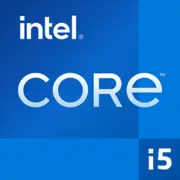Intel Core i5-1145G7

Intel Core i5-1145G7: Hybrid Power for Mobile Devices
Overview of the Tiger Lake Processor and Laptop Selection Recommendations
Architecture and Process Technology: 10 nm SuperFin and Iris Xe Graphics
The Intel Core i5-1145G7 processor, released in 2020, is part of the Tiger Lake lineup, marking Intel's transition to the 10-nanometer SuperFin process technology. This technology has improved energy efficiency and performance through an enhanced transistor structure and reduced resistance.
Cores and Threads:
The chip has 4 cores and 8 threads thanks to Hyper-Threading. The base frequency is 2.6 GHz, and in Turbo Boost mode, it can reach 4.4 GHz for one core and 4.0 GHz when all cores are under load. This frequency range allows for task adaptation: for example, when working in Excel, the processor quickly responds to user actions, while during video rendering, it evenly distributes the load.
Integrated Iris Xe Graphics:
The Iris Xe graphics accelerator with 80 EU (Execution Units) is a key advantage of the i5-1145G7. It supports DirectX 12, OpenGL 4.6, and delivers up to 1.3 TFLOPS of performance. In comparison, the previous generation (Iris Plus G7) had 64 EU and 1.1 TFLOPS. This makes the chip suitable for light gaming: for instance, in Fortnite on low settings, it can achieve 40-50 FPS at 1080p resolution.
Power Consumption and TDP: A Balance Between Power and Battery Life
The nominal TDP of the processor is 28 watts, classifying it as a chip for thin ultrabooks and business laptops. However, actual power consumption varies by scenario:
- In idle mode (browsing web pages), power can drop to 5-8 watts.
- Under full load (video editing), consumption can reach 35-40 watts, but only for short periods.
Laptop manufacturers can set the TDP between 12-28 watts, which affects performance. For example, compact devices (like the Dell XPS 13) often set a limit of 15-20 watts to reduce heat, resulting in a frequency decrease of 10-15%.
Performance: Office, Multimedia, and More
Geekbench 6:
- Single-Core: 1702 points. This is higher than the AMD Ryzen 5 5500U (1500) and Apple M1 (1600), making the i5-1145G7 a leader in single-threaded tasks.
- Multi-Core: 4973 points. Here, it trails behind the 6-core Ryzen 5 5600U (5200) and M1 (6200), but surpasses previous Intel generations.
Real-World Tasks:
- Office Work: Running 20 tabs in Chrome + Excel + Zoom — the processor handles this without lags, with temperatures not exceeding 60°C.
- Multimedia: Rendering a 10-minute video in Premiere Pro takes about 8 minutes (compared to 6 minutes for the Ryzen 5 5600U).
- Gaming: In CS:GO at medium settings — 70-80 FPS, in GTA V — 45-55 FPS.
Turbo Boost:
In turbo mode, the processor maintains high frequencies for 20-30 seconds, after which it reduces them due to overheating. Reliable cooling is critical for stable operation in demanding applications.
Usage Scenarios: Who is the i5-1145G7 Suitable For?
- Students and Office Workers: Quick document processing, video conferencing, multitasking.
- Creative Professionals: Photo editing in Lightroom, editing short videos.
- Casual Gamers: Indie games or online shooters at low settings.
Not recommended for:
- 3D modeling in Blender.
- Streaming games at high resolutions.
Battery Life: Energy-Saving Technologies
The average battery life for laptops with the i5-1145G7 is 8-10 hours under moderate load (web browsing, video watching). This is aided by:
- Intel Speed Shift: Dynamic switching between P-states (core frequencies) to minimize latency.
- Dynamic Tuning 2.0: An AI-based algorithm that predicts load and adjusts power accordingly.
However, when actively using Turbo Boost, battery life can drop to 3-4 hours.
Comparison with Competitors
- AMD Ryzen 5 5500U: Cheaper, but weaker in single-threaded tasks and graphics (Vega 7 vs. Iris Xe).
- Apple M1: Better energy efficiency and multi-threading, but limited compatibility with Windows applications.
- Intel Core i7-1165G7: Higher frequency (4.7 GHz) and 96 EU in graphics, but priced about 30% higher.
Pros and Cons
Strengths:
- High single-threaded performance.
- Powerful integrated graphics.
- Support for Thunderbolt 4 and Wi-Fi 6.
Weaknesses:
- Heating under prolonged load.
- Limited multi-threading due to 4 cores.
Laptop Selection Recommendations
1. Device Type: Ultrabook (such as Lenovo Yoga 7i) or business laptop (HP EliteBook 840 G8).
2. Cooling: Look for models with dual fans and heat pipes.
3. Screen: For Iris Xe, a display with a 60 Hz refresh rate and 1080p resolution is recommended.
4. Memory: At least 16 GB DDR4-3200 to unlock the CPU and iGPU's potential.
Final Verdict
The Intel Core i5-1145G7 is an excellent choice for those who value the balance between mobility and performance. It is suitable for:
- Users who need speed in everyday tasks.
- Those who want to play less demanding games without a discrete graphics card.
- Travelers needing long battery life.
If your budget allows, consider the i7-1165G7 for additional performance or the Ryzen 5 5600U for multi-threaded tasks. However, for most scenarios, the i5-1145G7 remains the optimal option in its category.
Basic
CPU Specifications
Memory Specifications
GPU Specifications
Miscellaneous
Benchmarks
Compared to Other CPU
Share in social media
Or Link To Us
<a href="https://cputronic.com/cpu/intel-core-i5-1145g7" target="_blank">Intel Core i5-1145G7</a>